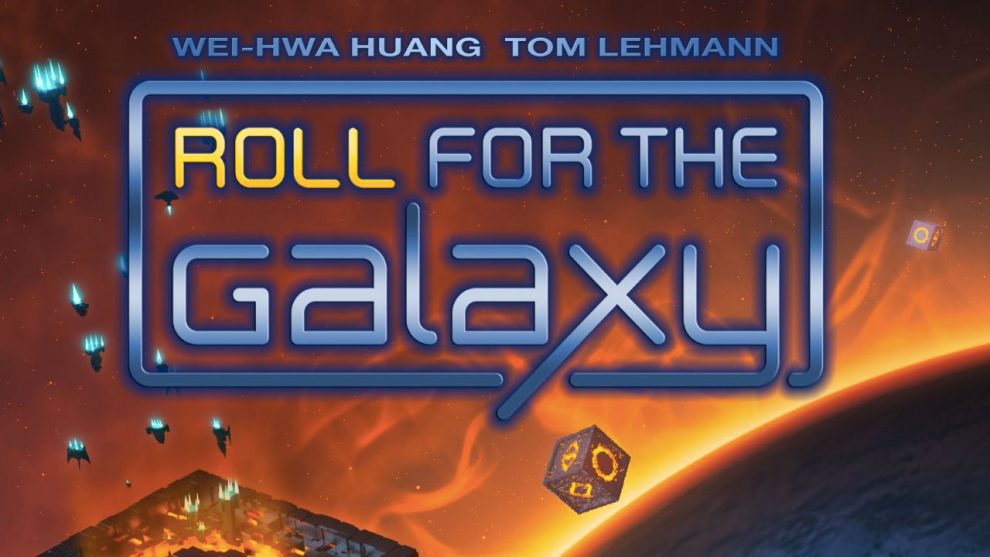Dice in an engine builder? That mix as well as Nutella on raw salmon. Who is responsible for this terrible crime? Tom Lehmann? The same guy behind Race for the Galaxy? Fine, let him go.
Roll for the Galaxy is a tableau engine builder using dice as the randomizer instead of cards. Each die represents a worker that specializes in different types of actions such as developing, shipping, or exploring. These actions are how you will expand your insignificant tiny faction into the powerhouse conglomerate of planets and technology. The game ends when all of the victory points chips run out or someone has 12 tiles in their tableau. Victory points are the name of the game and you get them colonizing planets, discovering technology, or shipping goods.
Usually, this is the part of the review where I would go through a somewhat detailed rules playthrough on how you play the game, but I cannot do that here. Much like its older brother, Roll for the Galaxy is hard to teach although not nearly as painful as Race. The main reason for this is the numerous steps and many of these steps require visual clarity.
It Can Get Confusing
Furthermore, this game introduces several mechanisms that I haven’t seen in other board games and this lack of familiarity is not the easiest thing to describe in short writing form. At most, I’ll not get into specifics as there is a lot of ground to cover here.
You will have your faction power, a cardboard shield, a phase strip behind said shield, a dice cup, and your starting dice. At the start of each round, everyone will roll the dice behind their shields. Each die will have symbols that correspond to a particular action you can do. There are no turns and everything is done simultaneously.

From there, you are going to allocate your dice and put them under the action selection strip to match their symbols to form a column. Once that is done, you will pick one of your dice and put it on the action selection strip itself in one of the five actions you wish to activate. After everyone has completed this, everyone will lift their shields to show the results.
There is where the player interactions come in. You can only pick one action to activate per round, but you must do the actions that you and other players picked. For example, if you picked Explore, Jim picked Develop, and I picked Produce, you must do all three if you can. The dice under each action represents the “strength” of the action. The more dice under each action, the more you can do. This interesting mechanic makes Roll for the Galaxy almost feel like a dorky version of Poker where the players are trying to outguess each other by examining their opponent’s behaviors, dice poll, and tableaus.
To add further complication to this matter, there are different colored dice. These colored dice aren’t just aesthetics as they also have different symbols on them. Red military dice are heavily skewed towards development and settlement but don’t have any trading or shipping symbols. Half of the yellow Alien’s dice sides are wild, making them highly flexible assets. This is yet another issue that you must tackle as colonizing new worlds means new dice to your dice pool which not only means more production, but chances of rolling the actions you want. However, each time you do an action, the dice used for that action are put into a Citizenry pool. You must repurchase them with credits, and that is yet another challenge to face.
Shipping goods are the primary ways to get credits and it’s an alternative to get victory points. Using the Produce action allows you to park your die on a planet and this is considered to be a “Good” while the Shipping action gives you the option to use those goods to either earn victory points or credits. Different types of goods, as determined by the die’s color, have different credit values such as the yellow Alien good being the most valuable, but they all give the same number of victory points.
/pic3222496.png)
Many Parts To This Machine
I did mention this is a tableau builder which means there has to be something to build. In this case, it’s double-sided tiles. Each time you do an Explore action, you will draw blindly from a bag and add it to your construction queue. Every single tile is unique and they will always have a planet on one side and development on the other. There is a consistent theme here: Planets will always give you a colored die and developments allow you to break rules. I have to admit that I love this mixture of randomization while still providing a meaningful choice.
All these systems result in a cocktail of choices that are constantly pulling your brain in several different directions at once. There is never a moment of relaxation since there is always a leaky hole for you to plug. If your credit economy is crap, grabbing your used dice will take numerous turns instead of one fell swoop. Failing to read other player’s intentions means they will piggyback off your selected actions while you get very little done in each turn. You also need to worry about the dice you roll and allocate them properly while trying to have a tableau of abilities that works well with your plan. It is a game that demands several different skill sets crashing through your walls all at once.
In theory, this works quite well and it is going to take several play sessions to appreciate all these nuances. In practice, there are some annoying issues and this is based on my experience of playing the game over 40 times.
Outside of shipping, you can score victory points by having tiles in your tableau. The problem here is spitting out tiles onto your tableau has a far lower barrier of entry to score points over shipping. With the shipping strategy, you need to build your entire game around it, whereas ending the game via 12 tiles requires you to mainly stack up with red Military dice and credit to buy them back. This isn’t to say that you can’t win with shipping, but don’t be surprised if the vast majority of your games are mainly a race to 12 tiles.
Not As Provocative As I hoped
Another glaring problem is the amount of dice mitigation. As mentioned previously, when you roll your dice behind the shield, you use one of your dice to pick the action. This die doesn’t have the match the symbol and will be used for that action. That’s fine on its own, but then it adds a “Dictate” option where you spend one of your dice to move another die to another action column that doesn’t match its symbol. Throw in Development tiles that allow you to reassign your dice and I can’t help but notice that this undermines the use of dice as a randomizer. I would’ve preferred a game with far more restrictions since I am a firm believer that restrictions breed creativity thus crafting a more interesting experience. I’m sure many others will likely disagree, but this has been my experience with the numerous sessions I had with this game.
Even though I have these issues, it is still an excellent game that stands on its own and it’s far better than most attempts I have seen at an engine builder. With that being said, I don’t think it is Tom Lehmann’s apex and I prefer his other work. I know this probably sounds like I’m a fanboy or an idiot, or a combination of the three, but hear me out.
Despite the cliff size learning curve, Race for the Galaxy is still a solid game even though it’s been in print since 2007. Once you accustomed to the hellscape of symbols, you’ll find the game manages to tug you around just as well as Roll for the Galaxy and give you a good amount of stress like a productive gym workout. If you are looking for something more refined, there is also New Frontier which fine-tunes many of the mechanisms found in Puerto Rico. Finally, my personal favorite would be Res Arcana, a game where you don’t need miles of cardboard to create an engaging tense engine builder.
All of these options are games I prefer over Roll for the Galaxy. In spite of this, I still view Roll as a far better game than most games in this genre. If anything, this demonstrates just how good Tom Lehmann is at this whole “game designer” gig.
You can find this game at Amazon US












” Much like its older brother, Roll for the Galaxy is hard to teach although not nearly as painful as Race. ”
A guy in my group says the same thing, while I think Race is much easier to get.
I’ve enjoyed playing this on Board Game Arena, but I don’t think I’d want to play IRL. There’s a lot of monkeying with dice behind screens. Not that I’m playing with cheaters, but it’s gotta be hard to even know if people are playing correctly.